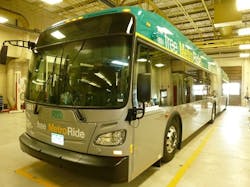In recent years the U.S. public transportation industry has been experiencing major growing pains. According to data from the American Public Transportation Association, riders took a staggering 10.7 billion trips on public transportation in 2013. As a result, transit administrators are under more pressure than ever before to protect their transportation districts from crime.
Despite the belief that there is safety in numbers, criminal activity has increased significantly as ridership numbers have swelled. To make things worse, equipment failure rates, inefficient offload processes and poor video quality are all issues that plague dated video surveillance systems being used by many transit agencies, making the role of administrators and public safety officials harder by the day. To overcome these issues, many agencies are looking to increase their adoption of IP-based, integrated transit security solutions to better address safety and security concerns and keep pace with the changing market requirements.
An example of such a system is one recently deployed by the Denver Regional Transportation District (RTD) Transit Police Division. Notably one of the largest public transportation systems in the nation, RTD has worked extensively over the past year to conceptualize and deploy a comprehensive mobile video surveillance system to meet the expectations of today’s public transit stakeholders, employees and riders.
As a result of this process, below are some key considerations transit officials should consider when evaluating new or updated video surveillance and security solutions.
High-speed Wi-Fi Connectivity
Integrated security solutions would be nothing without IP connectivity. With Denver RTD’s previous system, video surveillance data captured on its buses was stored on a DVR and manually pulled from the system, copied and stored as buses returned to the station. With hundreds of vehicles in use on a daily basis, this was a costly and time consuming endeavor. The new system deployed by Denver RTD leverages high-speed Wi-Fi connectivity to offload video files wirelessly as buses return to the depot or designated offload sites during the course of their routes. The system also enables transit safety officers at headquarters and in the field to access live video streams enabling administrators to improve safety for passengers and transit workers, protect physical assets and aid in the investigation of accidents or liability claims. In addition, law enforcement officials are able to access video from police cruisers once within a given range using their mobile computers and tablets, allowing administrators to streamline communications and expedite needed support in the event of an emergency.
HD Video Imagery
When considering a new video surveillance system, devices that offer HD video imagery are a must. RTD is using full HD 1080p and HD 720p network cameras inside and outside of each bus, integrated with other hardware and software components for recording, file transfer, viewing and management. In the past, Denver RTD investigators had to search through countless hours of surveillance recordings to investigate every incident. The new system leverages video management software with time-stamping capabilities to view and manage video files. It also integrates with various other video and audio sources and case files creating a unified event timeline no matter where in the district the incident may have occurred. These capabilities dramatically reduce the amount of time spent investigating incidents and ensure the availability of high-quality video evidence when it is needed.
Rugged Devices and Exterior Protection
Public transit vehicles endure years of near constant service, so every piece of a video surveillance system must be purpose-built to meet transportation agency specific requirements and survive a wide variety of environmental challenges. To overcome the climate and usage concerns of their fleet, RTD is utilizing rugged cameras that are engineered to withstand the wear and tear the buses and trains face on a daily basis. IP66-rated for weather, shock, impact and vandal resistance, the system can withstand the many internal and external stresses found in a transit environment. In addition, the cameras are shielded from factors such as impact from branches, extreme temperatures, and are strategically positioned to capture crystal clear, usable video evidence from every possible vantage point.
Comprehensive, Next-Generation Security for Public Transportation
By replacing their aging analog-based system with an integrated video surveillance and security solution, Denver RTD is now able to efficiently access high-quality video evidence in real-time, significantly improving situational awareness in buses, trains, platforms and stations. Following these best practices, transit administrators are able to improve overall safety and security for employees, the public, and transit assets while significantly improving operational efficiency, collaboration and data security. With these new, integrated transit surveillance solutions, the future of public transportation's security is here. Are you prepared?
Victor Vella is a recognized subject matter expert in anti- and counter-terrorism, law enforcement and physical security. He recently retired from the Federal Government and is now Senior Business Development Manager and Solution Owner Transit Surveillance Solution for Panasonic System Communications Company of North America.



